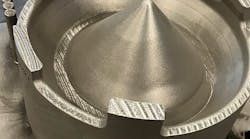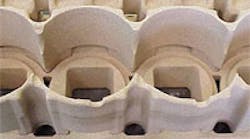Foundries must perform a great deal of up-front engineering to ensure casting quality is achieved on the first trial. In recent years, numerical tools for modeling metal flow, solidification, microstructure evolution and residual stresses have become commonplace.
However, one casting defect that has yet to be thoroughly addressed is the common core-gas blow defect. The physics of this problem involves a complicated interaction between the metal, core and binder and can scrap many castings before being solved. In most instances, the problem is merely managed – but never completely solved – by using a higher pour temperature and adding more wall stock to the affected areas.
The more complex the part design, though, the greater the chance for manufacturing problems. For any cast piece requiring internal details, chemically bonded sand cores must be “printed” to shape and placed inside the mold. Cores form the internal shape that is critical for the part’s ultimate function, and each step in the manufacturing process puts constraints on its design. Various requirements govern the core blowing process, handling, assembly and also gas venting. The art of core design is a fine balance between making the core sturdy enough to maintain its shape during heating, and ensuring that the bonding breaks down enough for removing the sand when the part has cooled.
Designing the optimum break-down
The mechanism of the planned core breakdown is the thermal conversion from solid to gas, but mold designs must then allow that gas to escape through the core print. If not, the metal may trap the bubbles and form pores. At best, the porosity is uncovered with surface machining; at worst, the part fails somewhere further down the line.
In the past, if materials and casting engineers found a porosity defect issue due to core-gas bubbles, they would step through a standard series of problem-solving tasks: reduce the binder content, increase the core venting, coat the core or possibly bake the cores ahead of time. Since it was impossible to see the path that the gas followed, this was a long drawn-out process often taking weeks to complete for one mold. And, it had to be repeated every time there was a problem with a different part.
The market-driven need to compress this processing timeline has prompted the development of casting simulation software. Useful for both design and manufacturing, computer-based modeling allows engineers to test a variety of approaches without any real-part cost or waste. To help foundries apply simulation specifically to venting design, Flow Science has recently added core-gas modeling to its FLOW-3D casting analysis capabilities.
Going with the flow
FLOW-3D is a computational fluid dynamics (CFD) software package that gives insight into a wide range of transient fluid-flow processes, whether the fluid is air, water, molten metal or a gas. Compared to other CFD packages, it is particularly accurate because of the way it models and tracks moving fluid surfaces.
Applying CFD methods to core-gas flow is a challenge. Due to the chemical complexity of resin-based binders, understanding just where and how the gas flows after sand-core thermal breakdown is a complicated process. However, Flow Science collaborated with several groups to obtain experimental data and compare results with those from the simulated models. The company gathered core-gas flow rate information from General Motors, Graham-White Manufacturing Co. and AlchemCast, getting real-world data on sand-resin cores used with aluminum, iron and steel.
Dr. David Goettsch, a casting analysis engineer at GM Powertrain, has used FLOW-3D for fifteen years for analyzing filling and solidification of metal castings. The new core-gas model has been quite useful for optimizing the jacket core venting at the design stage. It is very difficult to implement vent tracks into an existing core box with all the other demands on the core prints. “Upfront analysis work on core-gas venting can save you from high scrap rates during your start up,” he explains. “Perhaps process chances can solve the problem. But it may take a lengthy test period to get to that point.”
Defining the flow parameters
Depending on the temperature, the gas pressure can peak before the metal head pressure reaches the same value, causing the gas to form a bubble. Slight changes in the gate design can help increase the pouring rate, allowing the metal pressure to build faster and push out the gases first, but a physical trial-and-error approach takes time. Identifying which way to make geometry changes using a virtual model was a prime goal in developing the core-gas simulation software.
Flow Science’s developers combined the physics behind the flow with such process-specific parameters as the binder decomposition gas source, the degree of fineness of the sand, the amount of binder by weight percentage, the operating temperature and the physical permeability of the core. All of these values have been verified using industry calibration samples of sand-shell binders and polyurethane cold-box binders (PUCB).
The FLOW-3D analysis assumes an ideal gas of constant composition and takes the worst-case scenario of total binder decomposition. As conditions evolve within the core during the pour, the software calculates the changes in gas pressure, the geometry of the gas flow fields, the binder degradation-zone evolution and possible surface locations of gas blow into the metal. All data is available for post-processing; users can easily visualize the gas flow, zoom in and click on a point to get its specific values.
With the core-gas models now available in FLOW-3D v9.4, Goettsch can try different insertion and venting locations and get a global diagnosis: seeing how much gas develops, where it goes, and how much got out before the metal front caught up to it. “It’s very nice when you can actually see the root cause of the problem,” he says. “These visualizations are great to try to get a little window on what the real phenomenon is doing.”
Multi-core challenges Another experienced foundry engineer, Elizabeth Ryder of Graham-White Manufacturing echoes the opinion that gas porosity has always been difficult to investigate. She adds that, “Particularly with multiple cores, it was hard to pinpoint which core was the source of the problem. You tried to address the whole system.”
With ongoing production runs of 1,700 parts, some of them in quantities of 10,000 parts per year, Graham-White was very receptive to improving its manufacturing processes through simulation. Thin-walled parts are a particular problem, with their high core-to-metal ratio and lots of out-gassing.
Working with a 3D model of a grayiron part (roughly 34 in.) created by laser scanning, Graham-White provided the current venting design for evaluation. This gating design comprised four impressions per pattern plate in a horizontally parted mold, with each impression having vents for each core. A central sprue enabled filling each mold in less than two seconds.
Simulation with FLOW-3D software confirmed the fill rate, but also showed that one core had insufficient venting. Graham-White then began drilling deeper holes in the core to help channel more gas through the existing vents. Since switching its approach to the new venting design, the company has seen an approximately 30% decrease in core blow scrap.
Also based on the Flow Science analysis, the engineering group is evaluating a further change to the problematic core that would break it into two parts with additional venting for each part. Ryder says that FLOW-3D results helped narrow their design focus, letting them immediately zero in on which core (of a multi-core design) was the culprit, and even which area of the core was the problem source. “The more you can do on a computer ahead of time, the better,” she says. “It all comes down to saving time.”
Where to go from here
Foundries can reduce scrap and improve the efficiency of their core-print designs with the help of casting-simulation software. The new core-gas model in Flow Science’s FLOW-3D CFD analysis package is significant because it simulates critical porosity factors, helping designers evaluate a multitude of venting designs prior to first casting. Development continues on validating the core-gas model for additional materials and filling orientations.
| Pamela Waterman is a former design engineer and the president of EngineeringInk, a technical editorial service focused on mechanical hardware/software issues (www.EngineeringInk.com). Contact her at [email protected] |
















